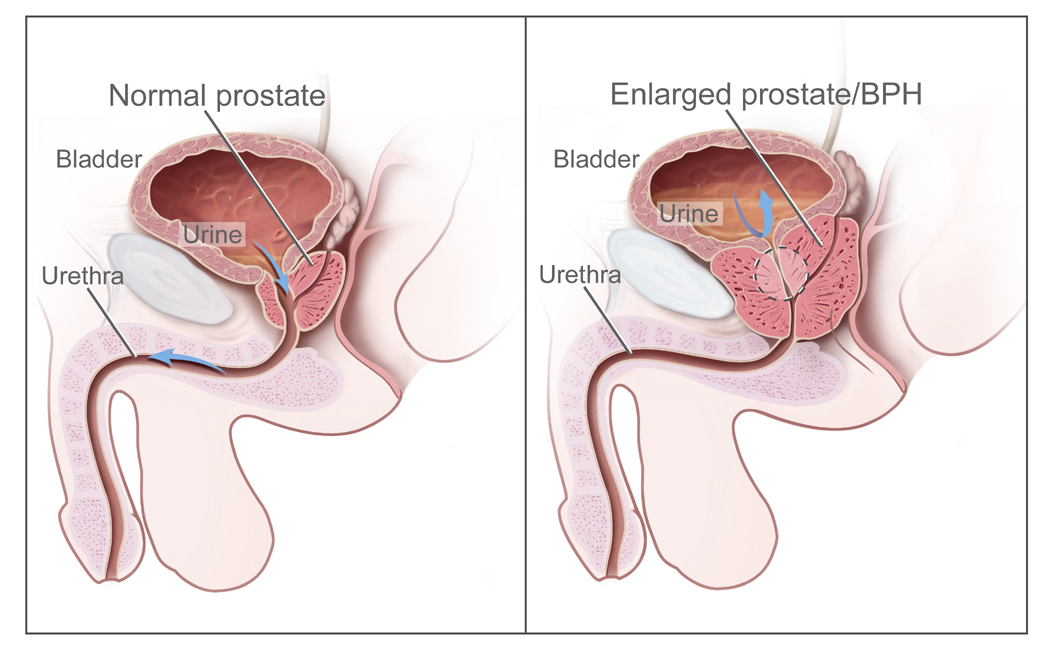Makindo Medical Notes"One small step for man, one large step for Makindo" |
|
|---|---|
| Download all this content in the Apps now Android App and Apple iPhone/Pad App | |
| MEDICAL DISCLAIMER: The contents are under continuing development and improvements and despite all efforts may contain errors of omission or fact. This is not to be used for the assessment, diagnosis, or management of patients. It should not be regarded as medical advice by healthcare workers or laypeople. It is for educational purposes only. Please adhere to your local protocols. Use the BNF for drug information. If you are unwell please seek urgent healthcare advice. If you do not accept this then please do not use the website. Makindo Ltd. |
Benign Prostatic Hyperplasia
-
| About | Anaesthetics and Critical Care | Anatomy | Biochemistry | Cardiology | Clinical Cases | CompSci | Crib | Dermatology | Differentials | Drugs | ENT | Electrocardiogram | Embryology | Emergency Medicine | Endocrinology | Ethics | Foundation Doctors | Gastroenterology | General Information | General Practice | Genetics | Geriatric Medicine | Guidelines | Haematology | Hepatology | Immunology | Infectious Diseases | Infographic | Investigations | Lists | Microbiology | Miscellaneous | Nephrology | Neuroanatomy | Neurology | Nutrition | OSCE | Obstetrics Gynaecology | Oncology | Ophthalmology | Oral Medicine and Dentistry | Paediatrics | Palliative | Pathology | Pharmacology | Physiology | Procedures | Psychiatry | Radiology | Respiratory | Resuscitation | Rheumatology | Statistics and Research | Stroke | Surgery | Toxicology | Trauma and Orthopaedics | Twitter | Urology
Related Subjects: |Urothelial tumour s |Haematuria |Acute Urinary Retention |Anuria and Oliguria |Bladder cancer |Renal cell carcinoma |Benign Prostatic Hyperplasia |IgA nephropathy |Prostate Cancer |Henoch-Schonlein purpura |Glomerulonephritis
🔵 Benign Prostatic Hyperplasia (BPH) is usually confined to the peri-urethral glands in the centre of the prostate. 📏 Importantly, prostate size does not always correlate with the degree of urinary obstruction.
📌 About
- Prostate size alone is not a reliable predictor of urinary outlet obstruction 🚫.
🧬 Pathology
- Represents hyperplasia (increase in cell number) rather than hypertrophy.
- Confined mainly to the peri-urethral (transition) zone.
- Prostate size ≠ severity of symptoms.

👨 Clinical
- Common in men >50 yrs; prevalence: Black > White > Asian.
- Voiding symptoms: weak stream, hesitancy, terminal dribbling 🚽.
- Storage symptoms: frequency, urgency, nocturia ⏰.
- Incomplete emptying → chronic retention with large bladder.
- Exam: smooth enlarged prostate, palpable bladder.
⚠️ Complications
- Acute urinary retention (can be worsened by drugs ❗ e.g. anticholinergics, antihistamines, antidepressants).
- Recurrent UTIs 🦠.
- Hydroureter, hydronephrosis, renal failure 🩸.
- Bladder calculi & infection.
🔍 Investigations
- Urinalysis (MSU if positive); haematuria → investigate for malignancy 🔎.
- Bloods: U&E, FBC, PSA (interpret carefully: ↑ with BPH, infection, cancer, recent catheterisation).
- KUB X-ray: consider if stone suspected.
- Post-void residual bladder volume (USS or catheter).
- 24-hr voiding diary: frequency & volume.
- Abdominal USS: kidney size, hydronephrosis, bladder wall.
- Flexible cystoscopy: if haematuria, obstruction, or diagnostic uncertainty.
- Urodynamics: in neurogenic bladder suspicion or failed prior prostate surgery.
💡 General Lifestyle Advice
- Limit alcohol 🍺, caffeine ☕, and evening fluids.
- Avoid decongestants/antihistamines as they worsen retention.
- Bladder training: urinate regularly (every 4–6 hrs). Double voiding can help.
- Maintain healthy weight & stay active 🏃 — reduces risk of retention.
- Keep warm 🧥 — cold triggers retention.
💊 Medical Management
- Alpha-blockers (Tamsulosin, Alfuzosin): relax smooth muscle → symptom relief. SE: postural hypotension, dizziness.
- 5-α reductase inhibitors (Finasteride, Dutasteride): shrink prostate (↓DHT). Takes 3–6 months; SE: retrograde ejaculation, ↓ libido.
- Combination therapy: in large prostates or severe symptoms.
- Anticholinergics (e.g. Oxybutynin): for storage symptoms; caution in frail elderly (delirium risk).
- Mirabegron: β3 agonist alternative for OAB; SE: hypertension.
🧴 Catheterisation & TWOC
- Acute retention: catheterise + start Tamsulosin → trial without catheter (TWOC) after 1–2 days.
- If fails: intermittent self-catheterisation or long-term catheter (urethral/suprapubic).
- Severe chronic retention (>1 L) → often requires long-term catheterisation.
📤 Indications for Urology Referral
- Suspicion of malignancy (hard nodular prostate, raised PSA).
- Obstructive uropathy: AKI, ↑ urea/creatinine.
- Large bladder, recurrent retention, or hydronephrosis.
- Rapidly worsening LUTS or failure of medical therapy.
🔪 Surgery: TURP
- Transurethral Resection of the Prostate (TURP): removes obstructive tissue via resectoscope.
- Benefits: strong urine flow & rapid relief.
- Complications: bleeding, TURP syndrome (dilutional hyponatraemia), clot retention, stricture, retrograde ejaculation, incontinence.
- Very large prostates → may need open prostatectomy.
Case 1 – Mild symptoms
58-year-old with daytime frequency and nocturia ×2. DRE normal, PSA ok, Post void residual 40 mL. Try lifestyle changes (less evening fluids, cut caffeine/alcohol). If still troublesome, start an alpha-blocker and review in 4–6 weeks.
Case 2 – Moderate symptoms, enlarged prostate
66-year-old with mixed LUTS (IPSS 18), smooth enlarged prostate, PSA 2.4 µg/L, volume ~45 mL, PVR 120 mL. Start tamsulosin and add a 5-alpha-reductase inhibitor (works over months). Consider bladder drug (e.g., mirabegron) only if PVR is low and storage symptoms persist.
Case 3 – Acute urinary retention
74-year-old unable to pass urine after a heavy night. Catheterise (record volume), start an alpha-blocker, check for UTI/culprit meds. Plan a trial without catheter in 2–7 days. If it fails or there are complications, refer for surgery (e.g., TURP/HoLEP) based on prostate size and fitness.